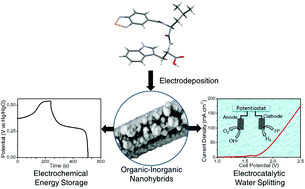当前位置:
X-MOL 学术
›
Sustain. Energy Fuels
›
论文详情
Our official English website, www.x-mol.net, welcomes your
feedback! (Note: you will need to create a separate account there.)
Engineering of electrodeposited binder-free organic-nickel hydroxide based nanohybrids for energy storage and electrocatalytic alkaline water splitting
Sustainable Energy & Fuels ( IF 5.0 ) Pub Date : 2019/12/10 , DOI: 10.1039/c9se00483a Rohit G. Jadhav 1, 2, 3, 4 , Devraj Singh 1, 2, 3, 4 , Shaikh M. Mobin 1, 2, 3, 4 , Apurba K. Das 1, 2, 3, 4
Sustainable Energy & Fuels ( IF 5.0 ) Pub Date : 2019/12/10 , DOI: 10.1039/c9se00483a Rohit G. Jadhav 1, 2, 3, 4 , Devraj Singh 1, 2, 3, 4 , Shaikh M. Mobin 1, 2, 3, 4 , Apurba K. Das 1, 2, 3, 4
Affiliation

|
Organic–inorganic nanohybrids are widely used as electrode materials for various applications due to their high conductivity with porosity and tuneable nanostructures. However, the poor stability of organic–inorganic hybrid materials in aqueous alkaline electrolytes and the presence of binders restrict their use in various electrochemical applications such as energy storage and electrocatalytic water splitting. A class of electrodeposited binder-free organic–inorganic hybrid materials based on a benzo[2,1,3]selenadiazole-5-carbonyl N-capped dipeptide (BSeLW) and metal hydroxide (Ni(OH)2) are prepared for electrochemical applications. The binder-free electrodeposited nanohybrids grown on carbon paper (CP) ((1 : 20) BSeLW/Ni(OH)2/CP) are stable in aqueous 1 M KOH electrolyte solution and exhibit pseudo-capacitive behavior with a high charge storage efficiency of 742 F g−1 at 1.5 A g−1. A prominent 71% specific capacitance retention at 10 A g−1 after 1000 cycles indicates higher stability of dipeptide-based organic–inorganic nanohybrids on the carbon paper-based electrode surface. Additionally, the nanohybrid shows catalytic activity for electrocatalytic water splitting with a low overpotential for the oxygen evolution reaction (OER) and hydrogen evolution reaction (HER) in alkaline aqueous 1 M KOH solution. This work elucidates the rational engineering of organic–inorganic binder-free multi-functional nanohybrid electrodes as a favorable candidate for high-performance energy storage and electrocatalyst for electrocatalytic water splitting.
中文翻译:

电沉积的无粘结剂有机镍氢氧化物纳米杂化材料的储能和电催化碱性水分解工程
有机-无机纳米杂化物因其高电导率,高孔隙率和可调节的纳米结构而被广泛用作各种应用的电极材料。但是,有机-无机杂化材料在碱性水溶液中的稳定性差,并且粘合剂的存在限制了它们在各种电化学应用中的使用,例如储能和电催化水分解。制备了一类基于苯并[2,1,3]硒二唑-5-羰基N封端的二肽(BSeLW)和金属氢氧化物(Ni(OH)2)的电沉积的无粘结剂有机-无机杂化材料。在碳纸(CP)((1:20)BSeLW / Ni(OH)2/ CP)在1 M KOH电解质水溶液中稳定并且在1.5 A g -1下表现出假电容特性,并具有742 F g -1的高电荷存储效率。在10 A g -1时具有显着的71%的比电容保持率经过1000个循环后,表明基于碳纸的电极表面上基于二肽的有机-无机纳米杂化物具有更高的稳定性。此外,纳米杂化物在1M KOH碱性水溶液中对氧分解反应(OER)和氢分解反应(HER)的电势低,对电催化水分解显示出催化活性。这项工作阐明了有机-无机无粘合剂多功能纳米混合电极的合理设计,可作为高性能能量存储和电催化水分解的电催化剂的理想候选者。
更新日期:2020-03-03
中文翻译:

电沉积的无粘结剂有机镍氢氧化物纳米杂化材料的储能和电催化碱性水分解工程
有机-无机纳米杂化物因其高电导率,高孔隙率和可调节的纳米结构而被广泛用作各种应用的电极材料。但是,有机-无机杂化材料在碱性水溶液中的稳定性差,并且粘合剂的存在限制了它们在各种电化学应用中的使用,例如储能和电催化水分解。制备了一类基于苯并[2,1,3]硒二唑-5-羰基N封端的二肽(BSeLW)和金属氢氧化物(Ni(OH)2)的电沉积的无粘结剂有机-无机杂化材料。在碳纸(CP)((1:20)BSeLW / Ni(OH)2/ CP)在1 M KOH电解质水溶液中稳定并且在1.5 A g -1下表现出假电容特性,并具有742 F g -1的高电荷存储效率。在10 A g -1时具有显着的71%的比电容保持率经过1000个循环后,表明基于碳纸的电极表面上基于二肽的有机-无机纳米杂化物具有更高的稳定性。此外,纳米杂化物在1M KOH碱性水溶液中对氧分解反应(OER)和氢分解反应(HER)的电势低,对电催化水分解显示出催化活性。这项工作阐明了有机-无机无粘合剂多功能纳米混合电极的合理设计,可作为高性能能量存储和电催化水分解的电催化剂的理想候选者。











































 京公网安备 11010802027423号
京公网安备 11010802027423号